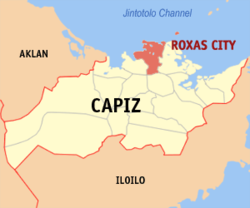Roxas City
|
Roxas City Lungsod ng Roxas Ciudad sang Roxas |
||
| Location of Roxas City in the Province of Capiz | ||
|---|---|---|

|
||
| Basic data | ||
| Region : | Western Visayas | |
| Province : | Capiz | |
| Barangays : | 47 | |
| District: | 1. District of Capiz | |
| PSGC : | 061914000 | |
| Income class : | 3rd income bracket | |
| Households : | 25.126 May 1, 2000 census
|
|
| Population : | 167.003 August 1, 2015 census
|
|
| Coordinates : | 11 ° 35 ' N , 122 ° 45' E | |
| Postal code : | 5800 | |
| Area code : | +63 36 | |
| Mayor : | Vicente B. Bermejo | |
| Geographical location in the Philippines | ||
|
|
||
Roxas City ( Filipino : Lungsod ng Roxas ; Hiligaynon : Ciudad sang Roxas ) is the capital of the Province of Capiz , located on the Panay River and on the northern tip of Panay Island in the western part of the Visayas in the Philippines . The inhabitants speak Hiligaynon there . Roxas City, also known for its cleanliness, is often referred to as the “Seafood Capital” of the Philippines.
history
Roxas City was originally founded in 1693 as a Spanish settlement by El Puebo de Capis . The Spanish conqueror Miguel Lopez de Legaspi settled here for a short time after the successful occupation of the island of Cebu. The then capital of the province was still the neighboring town of Panay. The city was later called "El Puerto de Capiz" .
The city remained relatively sparsely populated until the 17th century. In 1746, the Spanish military moved their headquarters to the city, until after a few decades the population grew. In 1760 there were already 17,683 inhabitants in the city. On May 31, 1847, Capis was declared alcadia (capital) of the province.
Since May 12, 1951, Roxas City has been registered by RA No. 603 an independent city and the provincial capital of Capiz . The city was named after the first President of the Philippines, Manuel Roxas .
Culture
Hiligaynon is the most widely spoken language, although Tagalog and English are widely understood. The population is mostly made up of Malay descendants and Negritos , but Filipinos of Chinese and Spanish descent are also present.
Every year at the beginning of December the Sinadya sa Halaran Festival is celebrated in honor of the city's foundation. The Diwal Harvest , officially known as the Roxas City Seafood Festival , celebrates the provincial honor as the country's center for seafood fishing. The prestigious Aswang Festival symbolizes and celebrates the province's cultural heritage through legends and myths.
Special sights are the Panay Bridge (1910), the Panubli-on Museum, the fishing port Libas Fishing Port and the fish market of Banica, the Capiz Bay Resort, the Lapu-Lapu Farm, the Moro watchtowers (1814) and the beaches of Baybay and culasi.
economy
The city's main products are coconuts , fruit , sugar cane , tobacco and rice . The city is also the center of the country for the mass production of fish and other seafood. The city's port facility is mainly used for local transportation and trade. Roxas City has a number of commercial centers and a significant number of hotels and resorts.
The city has eight technical colleges and one state university.
Administrative division
Roxas City is politically divided into 47 barangays .
|
|
|
Note: Población (Spanish for population) refers to several barangays in the center of a municipality in the Philippines.
Sons and daughters
- Victor Bendico (* 1960), Catholic clergyman, Bishop of Baguio
Web links
- Information about Roxas City (English)
